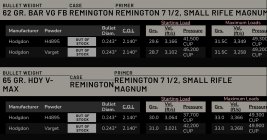Burn rate charts are a rough guide, nothing more. Reloaders tend to use powders within a certain burn rate "range" for loads with a given cartridge, bullet weight, and primer, largely because powders within that burn rate range have been proven over the years to work well with the combination they've chosen. For example, in a .308 Win with 185-210 gr bullets, you will find many FTR shooters using H4895, N140, Varget, and N150 powders (fastest to slowest).
It is also worth noting that each one of those powders is single-base, which tend to be more resistant to velocity variance due to temperature changes. The "classic" double-base powders are typically much less temperature-resistant than single-base powders, but will often net 100-200 fps greater velocity in a given load. The exception to that is some of the newer double-base powders with coatings that minimize temperature-sensitivity. IMR's Enduron powders are a good example of these new coatings which improve temperature-sensitivity. In general, F-Class shooters are usually unwilling to trade markedly greater temperature-sensitivity for a little more velocity, because temperature-sensitivity often means greater vertical dispersion at the target. So the intended use is also a critical part of the selection process.
Perhaps now more than at any other time, reloaders are experimenting with different powders due to lack of availability and/or cost of their "go to" powders. This is not necessarily a bad thing, but it means more work at the reloading bench and shooting range to get new loads dialed in. As an example of this, I bought several pounds of Accurate 4064 last year for use in a .308 Win "practice" load, mainly so as not to burn up all my Varget during practice. Based on the testing I have done so far, the AA4064 will work for the intended purpose, but it was really not the best choice. I bought it largely because it generally fell within the lower end of the accepted burn rate range for .308 Win with heavy bullets, and because it was actually available on a few different occasions. It is noticeably slower in terms of burn rate than Varget, which is OK, but it is also less energetic. What that means is that I cannot always reliably hit the same nodes I can hit with Varget. I have also discovered that it is stupidly temperature-sensitive, to the tune of about 2 fps per degree F, which means I have to work up probably three different loads for different temperature ranges so I can practice with it during the entire year. In spite of these drawbacks, it will likely work reasonably well for the intended use as a practice load to conserve my Varget for use in matches. At this point, I would not consider using the AA4064 in matches, but I didn't buy it for that purpose, so all is good.
With a little diligence and research, you can likely find a suitable replacement for Varget that is perhaps a bit easier to find, even if it may not be quite as good for the intended purpose. If you know anyone else loading for the same cartridge, you might even get a few people to go in together and buy a pound each of a few different candidates, which you can then test together to determine which might be the most suitable.











